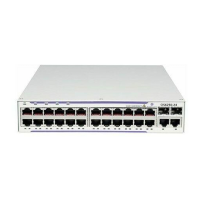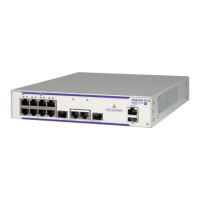Configuration and Image Loading
Page 124 7210 SAS D, E, K OS Basic System Configuration Guide
Ping Check in auto-init mode
If the system is booted up using the auto-init procedure, the runtime image performs a ping check
to make sure that the system has IP connectivity. The runtime image, after loading the
configurations from the configuration file, tries three times to ping the IP address specified as the
ping-address parameter in the BOF file, at a 2, 8 and 16 minutes interval minute interval. If the
ping does not succeed, the system is rebooted with BOF reset after 1 minute and the whole boot
process is repeated. If address in the BOF is zero or the ping address is not given, the ping check is
not done.
Configuration Guidelines for use of Auto-init and Manual mode
• Ethernet management port does not support Auto-Init mode. The use of DHCP to obtain
the BOF file from the network and other system parameters is currently not supported on
Ethernet management port.
• In auto-init mode, DHCP requests sent out by the node are in two formats. The system
attempts to communicate with the DHCP server in these two formats, one after another(if
necessary).
− Initially, the DHCP requests are sent out with a priority VLAN tag (VLAN ID =
0, Dot1p PCP bits set to 7).
− If no response is received from the DHCP server during the above request period,
DHCP requests are sent without VLAN tags (that is, null-tagged packets).
• In auto-init mode, DHCP client expects the following options to contain the BOF file
name and the server IP address. BOF file can be downloaded through FTP or TFTP based
on the information a client receives from DHCP server. Listed below are the ways in
which DHCP client will try to obtain the file:
− 1. Using the vendor specific option : The client searches for the option “43” in
the DHCP reply. This provides the URL which has to be accessed through FTP.
For example: ftp://abcd:xyz@10.0.0.2/test/bof.cfg. If this file is found the client
retrieves this file.
− 2. Collating server-name and file-name : If the option “43” is not found in the
DHCP reply, then a URL has to be formed by using the tftp-server name and the
boot-file retrieved via TFTP. IP address of TFTP server is obtained from DHCP
Option “66” or the "sname" field of a DHCP message and filename on the TFTP
server is obtained from DHCP Option “67” or the "file" field of a DHCP message.
• In the manual mode, if the OOB port is enabled (that is the “eth-mgmtdisable” is set to
“no”), the OOB port is used to download the TIMOS image file and configuration file
specified in the BOF file, and the system boot is successfully completed. If a system boot

